
XXXI Simpósio Brasileiro de Telecomunicações
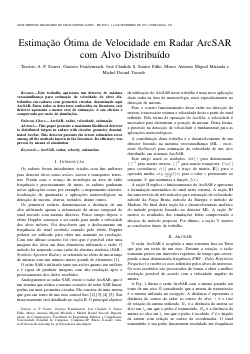
Estimação Ótima de Velocidade em Radar ArcSAR com Alvo Distribuído
Tarcísio A. P. Soares, Gustavo Fraidenraich, José Cândido S. Santos Filho, Marco Antonio Miguel Miranda, Michel Daoud Yacoub
DOI: 10.14209/sbrt.2013.141
Keywords: ArcSAR radar velocity estimation
Abstract
This paper presents a maximum likelihood detector to distributed targets in radars with circular geometry denominated ArcSar. This detector presents the lowest estimation error among all the methods known in the literature. Its efficiency was proven by means of simulation.Download
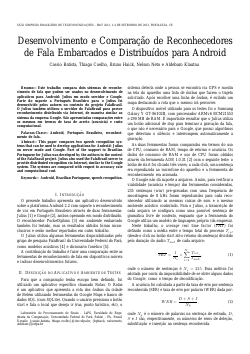
Desenvolvimento e Comparação de Reconhecedores de Fala Embarcados e Distribuídos para Android
Cassio Batista, Thiago Coelho, Bruno Haick, Nelson Neto, Aldebaro Klautau
DOI: 10.14209/sbrt.2013.151
Keywords: Android Brazilian Portuguese speech recognition.
Abstract
This paper compares two speech recognition systems that can be used to develop applications for Android: Julius on server mode and Google. Part of the support to Brazilian Portuguese for Julius was developed by the authors in the context of the FalaBrasil project. Julius also used the FalaBrasil server to provide distributed recognition via Internet, similar to the Google system. The systems are compared with respect to accuracy rate and computational cost.Download

Sistema de Localização de Fontes Sonoras Baseado em Algoritmo de Separação Cega
Luiz C. F. Nogueira, Mariane R. Petraglia
DOI: 10.14209/sbrt.2013.155
Keywords: Blind Source Localization Blind Source Separation Direction of Arrival
Abstract
This article describes a system for blind sound source localization, which uses two pairs of omnidirectional microphones. The localization method is based on algorithms developed for blind source separation and estimation of the angle of arrival. The inaccuracy in the source localization is analyzed in terms of the distance between the microphones in each pair, the reverberation of the environment, the distance between the source and the pair of microphones, and the proximity of the sources. Guidelines for positioning the microphones are derived from the results of the analysis in order to render the blind source localization system more precise.Download

A Framework for Adaptive PCR Jitter Correction in MPEG-2 TS Processors
Heitor J. Savino, Eddie B. L. Filho
DOI: 10.14209/sbrt.2013.152
Keywords: PCR correction MPEG-2 transport stream semaphore rate adaptation.
Abstract
Currently, the MPEG-2 Transport Stream (TS) is widely used in many transmission systems, like digital terrestrial television and internet protocol television networks. It is capable of carrying interleaved audio, video, system information, timing and generic data, in an unified transport framework. Regarding receiver synchronization, it employs the Program Clock Refer- ence (PCR), which is a snapshot of the transmitter 27 MHz clock and is used to adapt the local one. However, the PCR may present inaccuracies on its time base information, due to reprocessing or network variable delay. This paper introduces a methodology for adaptive PCR correction, which has the potential to reduce the output jitter due to stream modifications performed by the TS processor, depending on the characteristics of the input TS. Simulation results show that the proposed method is effective and outperforms traditional schemes presented in the literature, by keeping the output jitter level as close as possible to the one at the input.Download

Métrica de Eficiência em Redes de Rádio Cognitivo com Fila e Retransmissão Garantida
Rubem Toledo Bergamo, Paulo Cardieri
DOI: 10.14209/sbrt.2013.156
Keywords: Rede de rádios cognitivos filas com prioridade métrica Power.
Abstract
Este trabalho investiga o desempenho de uma rede de rádios cognitivos (rede secundária) que acessa de forma oportunista o canal licenciado aos usuários de uma rede primária. Emprega-se na análise a métrica power, definida como a razão entre a vazão de um enlace e o atraso observado pelos pacotes transmitidos nesse enlace. Os usuários das redes primária e secundária são modelados por meio de filas do tipo M/G/1, com prioridade para o usuário primário. São calculados os valores da métrica power para diferentes ordens de modulação, supondo retransmissões sem limite de pacotes recebidos com erro. Os resultados mostram que ordens de modulação elevadas diminuem o atraso, mas levam a enlaces pouco robustos, aumentando o número de retransmissões. Portanto, o desempenho da rede secundária, levando-se em conta vazão e atraso, pode ser maximizado pelo ajuste apropriado da ordem da modulação.Download
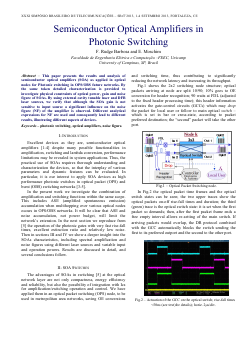
Semiconductor Optical Amplifiers in Photonic Switching
F. Rudge Barbosa, E. Moschim
DOI: 10.14209/sbrt.2013.157
Keywords: photonic switching optical amplifiers noise figure.
Abstract
This paper presents the results and analysis of semiconductor optical amplifiers (SOA) as applied in optical nodes for Photonic switching in OPS/OBS future networks. By the same token detailed characterization is provided to investigate physical constraints of optical power, gain and noise figure of SOAs. By using external cavity tunable laser and DFB laser sources, we verify that although the SOA gain is not sensitive to input source a significant influence on the noise figure (NF) of the amplifier is observed. Different analytical expressions for NF are used and consequently lead to different results, illustrating different aspects of devices.Download
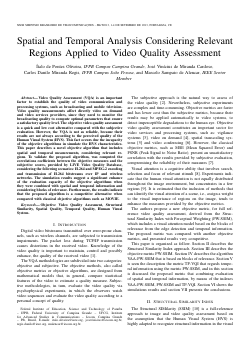
Spatial and Temporal Analysis Considering Relevant Regions Applied to Video Quality Assessment
Ítalo de Pontes Oliveira, Jose Vinícius de Miranda Cardoso, Carlos Danilo Miranda Regis, Marcelo Sampaio de Alencar
DOI: 10.14209/sbrt.2013.160
Keywords: Objective Video Quality Assesment Structural Similarity Spatial Quality Temporal Quality Human Visual System.
Abstract
Video Quality Assessment (VQA) is an important factor to establish the quality of video communication and processing systems, such as broadcasting and mobile television. Video quality measurements affect directly video on demand and video services providers, since they need to monitor the broadcasting quality to compute optimal parameters that ensure a satisfactory quality level. The objective video quality assessment is a quick and low cost alternative compared with the subjective evaluation. However, the VQA is not as reliable, because their results are not always according to the perceived quality of the Human Visual System (HVS). This fact occurs due the incapacity of the objective algorithms in simulate the HVS characteristics. This paper describes a novel objective algorithm that includes spatial and temporal measurements, considering relevant regions. To validate the proposed algorithm, was computed the correlations coefficients between the objective measures and the subjective scores, provided by LIVE Video Quality Database, considering the following scenarios: H.264 and MPEG-2 encoding and transmission of H.264 bitstreams over IP and wireless networks. The simulation results suggest a significant enhance of the evaluation capacity of the objective algorithms when they were combined with spatial and temporal information and considering blocks of relevance. Furthermore, the results indicate that the proposed algorithm is a competitive alternative when compared with classical objective algorithms such as MOVIE.Download
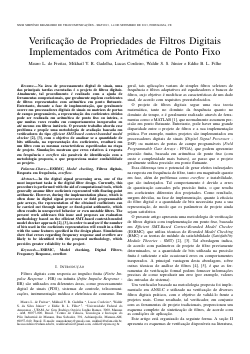
Verificação de Propriedades de Filtros Digitais Implementados com Aritmética de Ponto Fixo
Mauro L. de Freitas, Mikhail Y. R. Gadelha, Lucas Cordeiro, Waldir S. S. Júnior, Eddie B. L. Filho
DOI: 10.14209/sbrt.2013.161
Keywords: ESBMC Model checking Digital Filters Frequency Response overflow
Abstract
In the digital signal processing area, one of the most important tasks is the digital filter design. Currently, this procedure is performed with the aid of computational tools, which generally assume filter coefficients represented with floating-point arithmetic. However, during the implementation phase, which is often done in digital signal processors or field programmable gate arrays, the representation of the obtained coefficients can be carried out through integer or fixed-point arithmetic, which often results in unexpected behavior or even unstable filters. The present work addresses this issue and proposes an evaluation methodology based on the efficient SMT-based context-bounded model checker approach [2], [3], in order to analyze if the number of bits used in the coefficients representation will result in a filter with the same features specified in the design phase. Simulations show that errors regarding frequency response and overflow are likely to be identified with the proposed methodology, which provides greater reliability to the project.Download

Uma Aproximação Ortogonal para a DCT
R. S. OLIVEIRA, R. J. CINTRA, F. M. BAYER, C. J. TABLADA
DOI: 10.14209/sbrt.2013.162
Keywords: DCT algoritmos rápidos compressão de imagens.
Abstract
O presente trabalho introduz uma nova aproxi- mação ortogonal para a transformada discreta do cosseno de comprimento 8 baseada no trabalho de Brahimi-Bouguezel. O algoritmo rápido para a matriz de transformação proposta re- quer apenas 16 adições. No contexto de compressão de imagens, a transformação proposta supera várias aproximações arquivadas na literatura em termos de qualidade da imagem medida pelo erro quadrático médio.Download
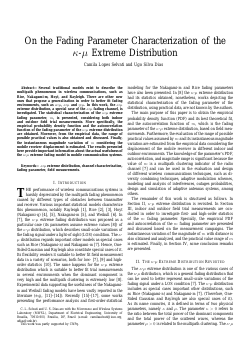
On the Fading Parameter Characterization of the κ-µ Extreme Distribution
Camila Lopes Selvati, Ugo Silva Dias
DOI: 10.14209/sbrt.2013.163
Keywords: κ-µ extreme distribution channel characterization fading parameter field measurements.
Abstract
Several traditional models exist to describe the multipath phenomenon in wireless communications, such as Rice, Nakagami-m, Hoyt, and Rayleigh. There are other new ones that propose a generalization in order to better fit fading environments, such as α-µ, κ-µ and η-µ. In this work, the κ-µ extreme distribution, a special case of the κ-µ fading channel, is investigated. The statistical characterization of the κ-µ extreme fading parameter, m, is presented, considering both indoor and outdoor field trial measurements. More specifically, the empirical probability density function and the autocorrelation function of the fading parameter of the κ-µ extreme distribution are obtained. Moreover, from the empirical data, the range of possible practical values is also obtained and discussed. Finally, the instantaneous magnitude variation of m considering the mobile receiver displacement is estimated. The results presented here provide important information about the actual usefulness of the κ-µ extreme fading model in mobile communication systems.Download